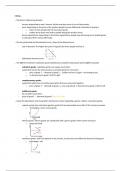Zusammenfassung
Summary Internationale Volkswirtschaftslehre - Supply and Demand, PED and XPED, Cost- and Profitfunctions
- Hochschule
- Gymnasium
Zusammenfassung für das Fach internationale Volks- und Betriebswirtschaftslehre: Nachfragekurve, Angebotskurve, Marktgleichgewicht, Preiselastizität, Kostenfunktion, Fixe und variable Kostenfunktionen, Gewinnmaximierung
[ Mehr anzeigen ]



